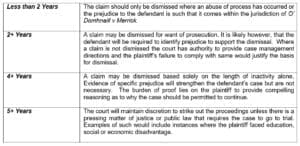From Delay to Dismissal | Implications of Kirwan Decision for Professional Indemnity (PI) Insurers
October 2025On 30 May 2025, the Supreme Court in Ireland delivered its decision in Kirwan v Connors[i] with a reformulation of the long standing Primor test as to when a defendant should bring an application seeking to strike out a claim for delay on the part of a plaintiff.
By reformulating the Primor principles, it is anticipated PI Insurers will have enhanced certainty on the prospects of bringing successful strike out applications where there has been prolonged delay by a plaintiff with the new test allowing a strike out application to succeed based solely on prolonged inactivity without the burden of demonstrating specific prejudice.
The Primor Test
The long established Primor test has been applied by the Irish Courts over the past 30 years in respect of any application seeking to strike out proceedings due to delay. The Primor test required a defendant to prove the delay was inordinate, inexcusable, and caused serious prejudice, so it tipped the balance of justice in favour of the plaintiff.
The Primor decision had a number of implications for PI Insurers to include long tail exposures in respect of dormant claims, greater unpredictability in terms of proving prejudice, complications in defence strategies due to aging evidence as well as significant defence cost implications.
Kirwan Case Overview
In May 2013, proceedings were issued by Kirwan, in respect of alleged professional negligence as against his solicitor regarding property development which was said to have occurred between 2005 and 2006. Following the issuing of proceedings no additional steps were taken by the Plaintiff to advance the proceedings. In 2018, the Defendant sought strike out of the proceedings pursuant to Order 122 Rule 11 of the Rules of the Superior Court.
Both the High Court and Court of Appeal found the delay by the Plaintiff to be inordinate and inexcusable and dismissed the case.
Despite this, in March 2023 the Supreme Court granted the Applicant leave to appeal on the basis that the Court had not had the opportunity to extensively examine the functions of the Primor decision since the establishment of the Court of Appeal in 2014. The case was ultimately reheard before a panel of seven judges in November 2024 and the judgment was delivered on 30 May 2025.
The Reformulated Test | The Kirwan Test
The Supreme Court affirmed the decision of the lower courts and sitting in a seven-judge panel, a unanimous decision was reached reemphasising that the power to dismiss claims stems from both Order 122 RSC and the courts’ inherent jurisdiction. Whilst there was a divergence of opinions regarding the formulation of the test from Hogan and Murray JJ, Chief Justice O’Donnell was of the view that the same rationale underpinned all.
As Chief Justice O’Donnell set out at para 7 of the Judgment, all members of the Court agreed on three important matters:
- That the experience of the 30 years since Primor v Stokes Kennedy Crowley was decided has shown that the Primor test has not achieved the objectives for which it was devised.
- It would be highly desirable that the Rules of the Superior Courts should be amended to include specific provision setting out the circumstances in which a case may be dismissed for want of prosecution.
- That whatever approach taken, whether by amended and adjusted Primor criteria (set out in the judgement of Hogan J), or by reference to order 122, Rule 11 (as set out in the judgment of Murray J) or existing Primor jurisprudence (as set out in the judgment of Collins J), the result is the same, boththe High Court and the Court of Appeal were correct to dismiss both the 2013 and 2012 proceedings.
O’Donnell CJ identifies key periods of inactivity and concluded on a sliding scale the reformulated the principles that should apply, which are as follows:

O’Donnell CJ concluded by stating that the amended principles should be successful in reducing drawn-out proceedings and associated appeals but he also gave the view that they are not absolute. He emphasised that the courts will still retain discretion to use their judgment for cases which lie on the border.
What does this mean for PI Insurers?
The most significant impact for PI Insurers is that these principles allow for more efficient claims handing. They provide clearer timelines and insurers will have greater certainty on the prospects of bringing a successful strike out application where there has been a significant period of inactivity by a plaintiff in progressing proceedings, without the necessity of proving prejudice:
- Clear Time Thresholds: A 2+ year period of inactivity will allow the court to impose case management directions and/or dismissal of the proceedings, depending on the specific circumstances. This will expedite the resolution of outstanding matters and assist with minimising costs exposure.
- Court Case Management: Stricter case management directions anticipated in cases with prolonged inactivity of 2 – 4 years which will result in greater certainty in reaching conclusions in dormant files.
- Delay Alone: The passage of time in itself will allow for the dismissal of proceedings where the delay has lasted for 4+ years and +5 years of inactivity, the courts have a broad power to strike out proceedings save in exceptional circumstances, which will assist with facilitating the timely closure of dormant files.
As a specialist insurance law firm, we have been advising professionals and their insurers in the defence of professional negligence claims for many years. We have extensive knowledge of the litigation process and are highly experienced in securing successful strike out applications for our clients. If you would like more information on anything we have covered in this article or to discuss any issues you may be having, please contact the authors or your usual Beale & Co contact.
[i] Kirwan v Connors [2025] IESC 21
Judgments | The Courts Service of Ireland









